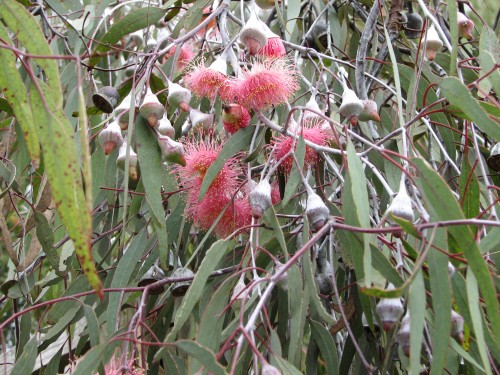How to plant Australian native plants
Early autumn is an excellent time for planting Australian native plants. The soil is still warm, the extremes of temperature have, in general, passed and rainfall becomes established again in the temperate areas of Australia.
Good gardening practice will always give good results for planting any types of plants, and Australian natives are no exception to this rule.
1. *Weed control is most important. Remove all weeds from the area to be planted. Be aware that cultivating the soil often will encourage weeds to establish. (On the other hand some native grasses will establish on uncultivated soil).
2. *Prepare the soil by forking to at least the depth of the root system, plus half again, and a diameter of 30-50cm (12-18inches) depending on the pot size.
3. Dig in whatever well rotted organic matter you may have, or keep it to apply to the soil surface.
4. I find it a useful thing to fill the planting hole with water and allow the water to drain away. This not only gives moisture in the subsoil to encourage roots downwards, but enables you to check the drainage of the area.
5. Create a raised planting site by bringing in soil from another area of the garden, if poor drainage is a problem or
6. Add gypsum to the soil if water seems to sit too long in the planting hole. About a kilo per square metre is recommended on poorly draining soils ie those that are mostly clay.
7. If water sits on the surface and seems to bead, non wetting soil is probably the problem. Buy a suitable soil re-wetting agent and follow the directions on the container. These are usually added after the planting is done. Similarly when watering fails to wet potting mix, dunk the container in a bucket or tub such as a garbage bin and if necessary add soil wetter to the water or the surface of the pot depending on the product being used.
8. *In general it is a good idea to soak potted plants in a bucket of water with some soil wetting agent added to it just before planting. (Unless you know for sure that the pot already contains this.) Soak long enough for bubbles to stop rising.
9. Adding fertilizer to the soil immediately below the plant can be a good thing. Use about a tablespoon of slow release fertilizer suitable for native plants, or use blood and bone added to the soil used to put around the plant in the planting hole.
10. *When placing the plant, create a small depression in the soil to act as a water catchment for rain or as a dam for hand watering.
11. *Plants need to be established by regular watering around the roots for several weeks, then weekly watering then leave greater intervals, depending on the amount of rainfall received. Don’t expect the plant to survive on natural rainfall if autumn rains have not begun in your district.
12. *Mulch the area surrounding the plant, keeping the mulch back a little from its stem.
13. *Use inorganic mulches like small sized gravel or sand that is free of weed seed.
14. *Or use organic mulches which will break down over time and need replenishing, but in doing so will add humus to the soil.
15. *Suitable organic mulches would be bark or wood chip, pea straw, rotted lawn clippings, or other rotted vegetable material or waste material.
The points marked * are the minimum that should be done.

Can you recommend plants for an area that becomes very wet after rain. The top soil is sandy but in this particular area the clay base is closer to the surface.